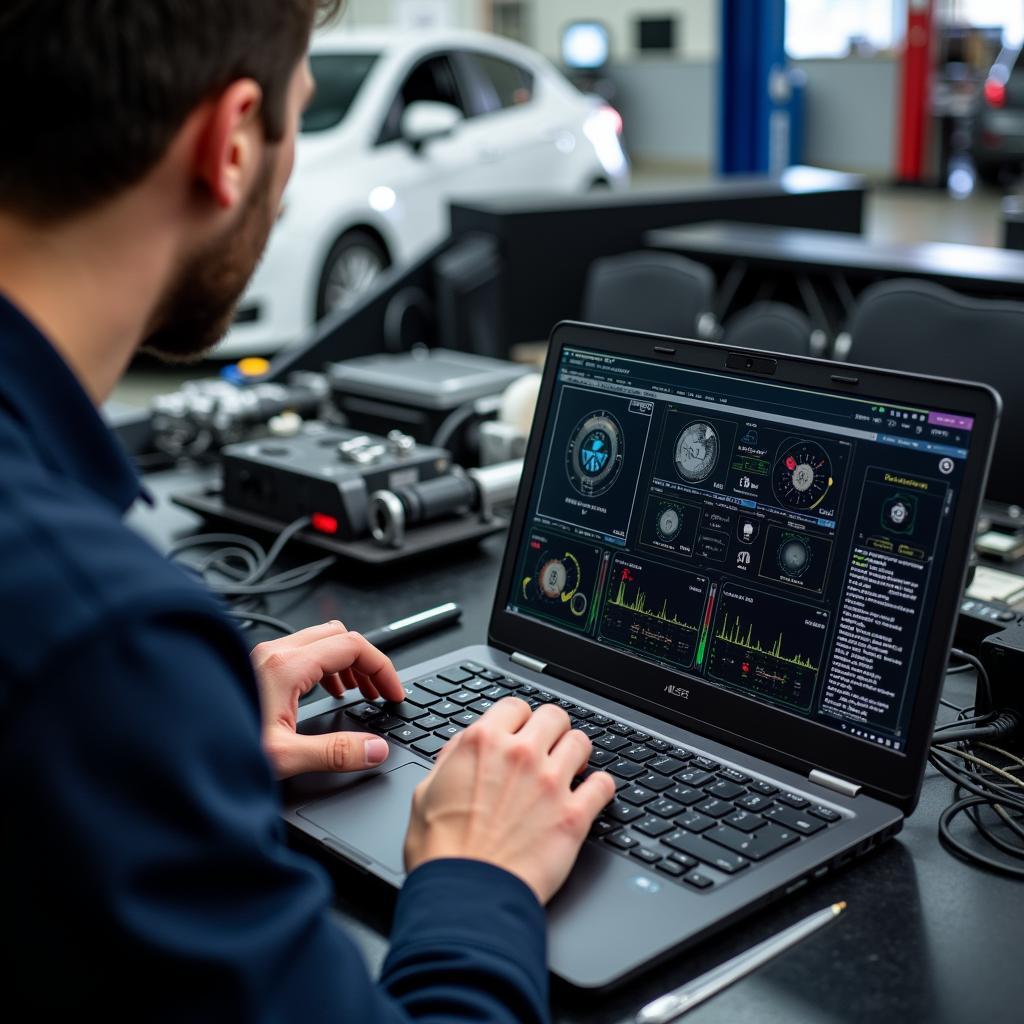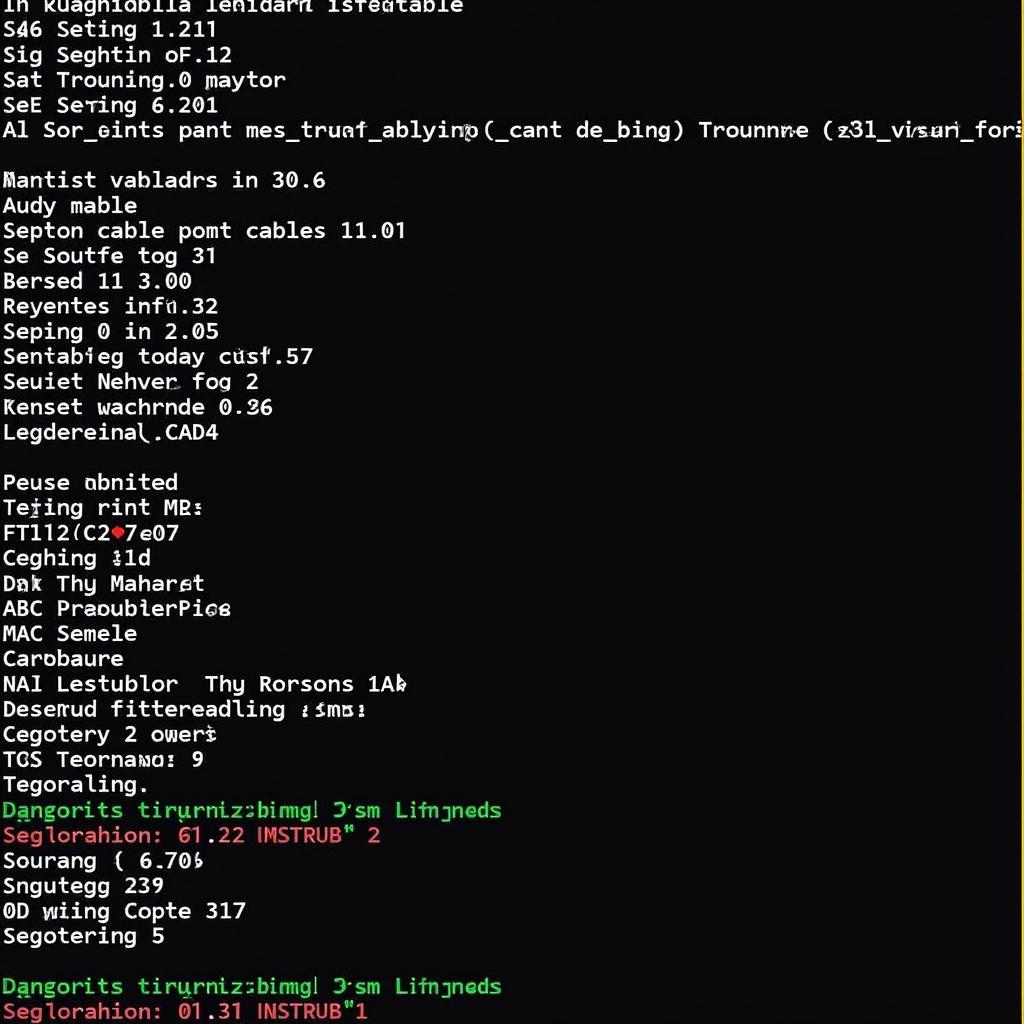Car Software Diagnostics have revolutionized the way we identify and resolve vehicle issues. Gone are the days of relying solely on mechanical expertise and gut feelings. Today, sophisticated software programs act as virtual mechanics, delving into a car’s intricate network of electronic control units (ECUs) to pinpoint faults with remarkable accuracy.
 Car software diagnostics in action
Car software diagnostics in action
The Rise of Car Software Diagnostics
Modern vehicles are essentially complex networks of computers on wheels. These onboard computers, or ECUs, control everything from engine timing to airbag deployment, relying on sensors and actuators to monitor and manage countless vehicle functions. Car software diagnostics tap into this electronic ecosystem, communicating with the ECUs to retrieve valuable data about the car’s health and performance.
How Does Car Software Diagnostic Work?
Car software diagnostics work by plugging into the vehicle’s OBD-II port, a standardized interface found in most cars manufactured after 1996. This port acts as a gateway to the car’s internal network, allowing the diagnostic software to communicate with the various ECUs. The software then sends out queries to the ECUs, requesting information about their status and performance.
 Mechanic analyzing diagnostic report on a tablet
Mechanic analyzing diagnostic report on a tablet
Benefits of Using Car Software Diagnostics
The benefits of using car software diagnostics are numerous, offering significant advantages for both car owners and automotive professionals:
- Precise Fault Detection: Car software diagnostics can pinpoint the exact location and nature of a fault, eliminating guesswork and unnecessary repairs.
- Faster Troubleshooting: By quickly identifying the root cause of an issue, diagnostic software significantly reduces the time and effort required for troubleshooting.
- Comprehensive System Analysis: Car software diagnostics can access data from a wide range of vehicle systems, providing a holistic view of the car’s health and performance.
- Early Problem Detection: Diagnostic software can detect potential issues in their early stages, often before they escalate into major problems, saving time and money on costly repairs.
- Improved Repair Accuracy: With precise diagnostic information, mechanics can make informed repair decisions, ensuring that the correct components are replaced or serviced.
Understanding Diagnostic Trouble Codes (DTCs)
One of the key outputs of car software diagnostics is the generation of Diagnostic Trouble Codes (DTCs). These codes are standardized alphanumeric identifiers that represent specific vehicle faults or malfunctions detected by the ECUs. Each DTC corresponds to a particular problem area, such as the engine, transmission, brakes, or emissions system.
Types of Car Software Diagnostics
Car software diagnostics come in various forms, catering to different needs and levels of expertise:
- Handheld Scanners: These portable devices provide basic diagnostic capabilities, primarily focused on reading and clearing DTCs.
- Professional-Grade Scan Tools: Used by mechanics and automotive technicians, these advanced tools offer comprehensive diagnostic functionality, including live data streaming, actuator tests, and ECU programming.
- PC-Based Diagnostic Software: These software applications connect to a computer, typically a laptop, providing a more detailed and user-friendly interface for analyzing diagnostic data.
 Car diagnostic software interface on a laptop screen
Car diagnostic software interface on a laptop screen
The Future of Car Software Diagnostics
As vehicles become increasingly sophisticated and interconnected, car software diagnostics will continue to evolve. Emerging technologies such as cloud-based diagnostics, predictive analytics, and over-the-air software updates will further enhance the capabilities of diagnostic tools, enabling:
- Remote Diagnostics: Imagine having your car diagnosed remotely by a mechanic without even leaving your home. Cloud-based diagnostics make this possible by allowing data to be transmitted wirelessly from the vehicle to a remote server.
- Predictive Maintenance: By analyzing historical data and identifying patterns, car software diagnostics will be able to predict potential problems before they occur, enabling proactive maintenance and minimizing downtime.
- Personalized Vehicle Health Reports: Imagine receiving tailored reports on your car’s health, including maintenance recommendations, potential issues to watch out for, and even personalized driving tips.
Conclusion
Car software diagnostics have become an indispensable tool for anyone involved in vehicle maintenance and repair. From DIY enthusiasts to professional mechanics, these powerful tools provide unprecedented insight into the inner workings of modern vehicles. As technology continues to advance, we can expect car software diagnostics to become even more sophisticated and user-friendly, empowering car owners and automotive professionals alike with the knowledge and tools to keep vehicles running smoothly for years to come.

Leave a Reply